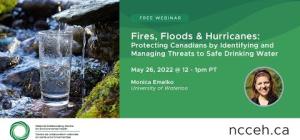Disasters can cause disruption to water supplies affecting homes, businesses and public services. Are you prepared for a water emergency? This video will teach you how to access safe drinking water in an emergency.
The recommended emergency water supply for drinking, cooking, washing and other needs is four liters per person per day for at least three days. An emergency water supply should be sealed, stored in a clean area out of direct sunlight, and refreshed about every 6 months. Find out who your water supplier is and keep their contact details on hand. Listen for advisories or check online for updates.
If you find yourself unprepared, what can you do? Emergency water may be available in or around your home or business. Ice cubes, kettle water or remaining water in your pipes and hot water tank can be relatively safe sources in an emergency.
If you look for water sources outside such as rain water or surface waters, keep in mind that even water that is free of odour, colour, and debris can still contain harmful bacteria or other contaminants. Reduce your risk by collecting water protected from pollution using clean collection vessels. Never consume water affected by blue-green algae as harmful toxins may
be present.
If you must use an outside water source, consider these treatment principles: first, let any debris settle before pouring off the clear water into a clean container. Next pour the clear water through a water filter, coffee filter, or other clean material to catch remaining debris. Most importantly, disinfect the water by boiling for several minutes. In a power outage, you could boil your water outside using a camp stove or BBQ. You can also disinfect your water after filtration using chlorine tablets according to the instructions or add 1 to 2 drops of unscented household chlorine bleach per one liter of water.
To sum up, plan ahead for a water emergency. Store at least a three-day supply per person. Keep water supplier details on hand and listen for advisories or check online for updates from official sources. If you must use alternative water sources, look for the safest sources first. Treat water using settlement, filtration, and disinfection by boiling or chlorination. Don't forget to check on others who may need help. For more information on emergency preparedness contact your provincial or territorial emergency management organization. Contact details can be found at getprepared.gc.ca










